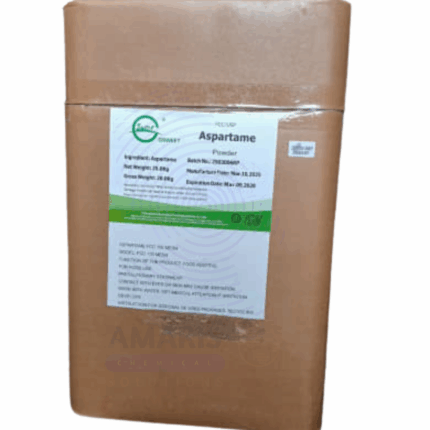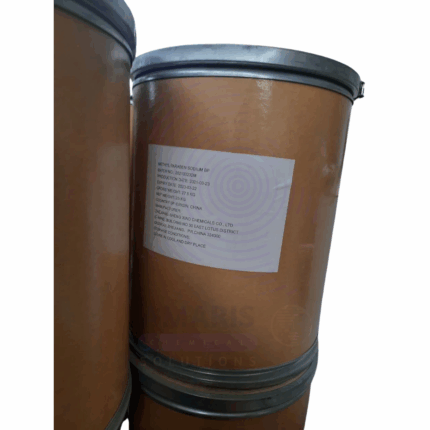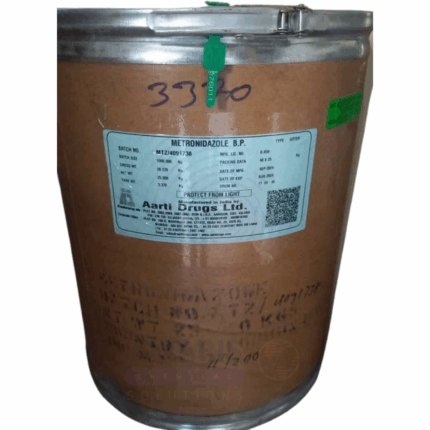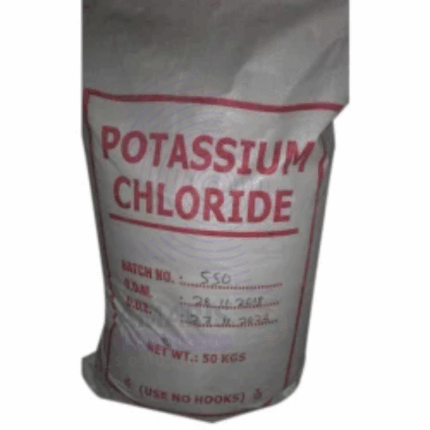
Aspartame FCC IV 100 Mesh
Aspartame FCC IV 100 Mesh is a high-purity, fine crystalline powder form of aspartame, meeting Food Chemicals Codex (FCC) grade IV specifications, and ground to a 100 mesh particle size. This fine particle size improves its solubility and dispersibility in beverages and other formulations. Aspartame is an intense artificial sweetener approximately 200 times sweeter than sucrose. It is widely used as a low-calorie sugar substitute in various food, beverage, pharmaceutical, and personal care products. This form is preferred for applications requiring rapid dissolution and uniform sweetness.
-
Table of Contents Toggle
Uses
Primary Uses
Food & Beverage Industry
- Used extensively as a sugar substitute in diet soft drinks, sugar-free beverages, and powdered drink mixes for low-calorie formulations.
- Incorporated in sugar-free chewing gums, candies, jellies, and confectioneries for intense sweetness without added calories.
- Used in dairy products such as low-fat yogurts, ice creams, and puddings to provide sweetness with reduced caloric content.
- Ideal for tabletop sweeteners and sugar substitutes in granular or powdered form due to fine particle size for better dissolution.
Pharmaceutical Industry
- Added to chewable tablets, syrups, and vitamin formulations to mask bitter tastes without impacting caloric intake.
- Used in diabetic-friendly medications and supplements to improve palatability.
Personal Care & Oral Hygiene Products
- Utilized in toothpaste, mouthwash, and breath fresheners as a sweetening agent that does not promote dental caries.
Secondary Uses
Dietary & Nutritional Supplements
- Incorporated in protein shakes, meal replacement powders, and vitamin supplements as a non-caloric sweetener.
Veterinary Applications
- Used to enhance palatability in flavored veterinary medicines and feeds.
Industrial Applications
- Employed in certain biotechnology applications where sweetness is needed but caloric input must be minimized.
Food Packaging Innovations
Occasionally used in active packaging technologies as part of oxygen scavenging systems (indirect effect to preserve food quality).
1. Basic Identification Attributes
- Chemical Name (IUPAC): L-α-Aspartyl-L-phenylalanine methyl ester
- Common/Trade Name: Aspartame FCC IV 100 Mesh
- CAS Number: 22839-47-0
- HS Code: 2932.19.00
- Molecular Formula: C₁₄H₁₈N₂O₅
- Synonyms:
- N-L-α-Aspartyl-L-phenylalanine 1-methyl ester
- E951 (EU food additive code)
2. Physical & Chemical Properties
- Physical State: Fine crystalline powder
- Color & Odor: White, odorless or faintly sweet aroma
- Particle Size: 100 mesh (approximately 150 microns)
- Melting Point: ~246 °C (decomposes)
- Density: ~1.3 g/cm³
- Solubility: High solubility in water (~50 g/L at 20°C), slight solubility in ethanol
- pH Level: Stable between pH 4 to 6
- Vapor Pressure: Negligible
- Flash Point: Non-flammable
- Autoignition Temperature: N/A
3. Safety & Hazard Attributes
- Hazard Class (GHS): Generally Recognized as Safe (GRAS)
- NFPA Ratings: Health 1, Flammability 0, Reactivity 0
- Exposure Limits: No specific OSHA/ACGIH limits
- Reactivity: Stable under normal conditions; sensitive to heat and moisture
4. Storage & Handling Attributes
- Storage Conditions: Store in a cool, dry, and well-ventilated area away from heat and moisture
- Container Type: Airtight moisture-proof containers such as HDPE drums or glass bottles
- Shelf Life: 2–3 years when stored properly
- Special Handling: Avoid moisture uptake and high temperatures to maintain potency and prevent degradation
5. Regulatory & Compliance Attributes
- FDA (USA): Approved as a food additive (21 CFR 172.804)
- EFSA (EU): Approved as a sweetener (E951)
- JECFA: Acceptable Daily Intake (ADI) of 40 mg/kg body weight
- Hazard Symbols (GHS): None
- Transportation Restrictions: Not regulated as hazardous
- Waste Disposal: Dispose according to local regulations; non-hazardous
6. Environmental & Health Impact
- Ecotoxicity: Low aquatic toxicity
- Persistence: Biodegradable; breaks down into amino acids in the environment
- Carcinogenicity/Mutagenicity: Not classified as carcinogenic or mutagenic
Biodegradability: Readily biodegradable
-
Safety Handling Precautions
- PPE: Use gloves, safety goggles, and dust masks to prevent inhalation and skin contact.
- Handling: Handle in well-ventilated areas; avoid generating dust.
- Storage: Keep containers tightly closed and stored away from moisture and heat.
- Hygiene: Wash hands thoroughly after handling; avoid eating or drinking during use.
- Dust Control: Use local exhaust ventilation or dust collection systems.
First Aid Measures
- Inhalation: Move to fresh air; seek medical attention if respiratory distress occurs.
- Skin Contact: Wash skin with soap and water; consult a physician if irritation occurs.
- Eye Contact: Rinse eyes with plenty of water for 15 minutes; seek medical advice if irritation persists.
- Ingestion: Rinse mouth with water; seek medical attention if large quantities are ingested.
Firefighting Measures
- Fire Hazards: Non-flammable under typical conditions; may decompose at high temperatures releasing irritant gases.
- Extinguishing Media: Use water spray, foam, or dry chemical powder.
Special Precautions: Firefighters should use protective equipment and breathing apparatus.


 Preservatives(food)
Preservatives(food) Flavor Enhancers
Flavor Enhancers Acidulants
Acidulants Sweeteners
Sweeteners Antioxidants
Antioxidants Colorants(food)
Colorants(food) Nutraceutical Ingredients (food)
Nutraceutical Ingredients (food) Nutrient Supplements
Nutrient Supplements Emulsifiers
Emulsifiers
 Collectors
Collectors Dust Suppressants
Dust Suppressants Explosives and Blasting Agents
Explosives and Blasting Agents Flocculants and Coagulants
Flocculants and Coagulants Frothers
Frothers Leaching Agents
Leaching Agents pH Modifiers
pH Modifiers Precious Metal Extraction Agents
Precious Metal Extraction Agents
 Antioxidants(plastic)
Antioxidants(plastic) Colorants (Pigments, Dyes)
Colorants (Pigments, Dyes) Fillers and Reinforcements
Fillers and Reinforcements Flame Retardants
Flame Retardants Monomers
Monomers Plasticizers
Plasticizers Polymerization Initiators
Polymerization Initiators Stabilizers (UV, Heat)
Stabilizers (UV, Heat)
 Antifoaming Agents
Antifoaming Agents Chelating Agents
Chelating Agents Coagulants and Flocculants
Coagulants and Flocculants Corrosion Inhibitors
Corrosion Inhibitors Disinfectants and Biocides
Disinfectants and Biocides Oxidizing Agents
Oxidizing Agents pH Adjusters
pH Adjusters Scale Inhibitors( water)
Scale Inhibitors( water)
 Antioxidants(cosmetic)
Antioxidants(cosmetic) Emollients
Emollients Fragrances and Essential Oils
Fragrances and Essential Oils Humectants
Humectants Preservatives
Preservatives Surfactants(cosmetic)
Surfactants(cosmetic) Thickeners
Thickeners UV Filters
UV Filters
 Fertilizers
Fertilizers Soil Conditioners
Soil Conditioners Plant Growth Regulators
Plant Growth Regulators Animal Feed Additives
Animal Feed Additives Biostimulants
Biostimulants Pesticides (Herbicides, Insecticides, Fungicides)
Pesticides (Herbicides, Insecticides, Fungicides)
 Active Pharmaceutical Ingredients (APIs)
Active Pharmaceutical Ingredients (APIs) Excipients
Excipients Solvents(pharmaceutical)
Solvents(pharmaceutical) Antibiotics
Antibiotics Antiseptics and Disinfectants
Antiseptics and Disinfectants Vaccine Adjuvants
Vaccine Adjuvants Nutraceutical Ingredients (pharmaceutical)
Nutraceutical Ingredients (pharmaceutical) Analgesics & Antipyretics
Analgesics & Antipyretics
 Analytical Reagents
Analytical Reagents Solvents(lab)
Solvents(lab) Chromatography Chemicals
Chromatography Chemicals Spectroscopy Reagents
Spectroscopy Reagents microbiology-and-cell-culture-reagents
microbiology-and-cell-culture-reagents Molecular Biology Reagents
Molecular Biology Reagents Biochemical Reagents
Biochemical Reagents Inorganic and Organic Standards
Inorganic and Organic Standards Laboratory Safety Chemicals
Laboratory Safety Chemicals Specialty Laboratory Chemicals(Special Laboratory Equipment)
Specialty Laboratory Chemicals(Special Laboratory Equipment)
 Demulsifiers
Demulsifiers Hydraulic Fracturing Fluids
Hydraulic Fracturing Fluids Scale Inhibitors(oil)
Scale Inhibitors(oil) Surfactants(oil)
Surfactants(oil) Drilling Fluids
Drilling Fluids
 Dyes and Pigments
Dyes and Pigments Bleaching Agents
Bleaching Agents Softening Agents
Softening Agents Finishing Agents
Finishing Agents Antistatic Agents
Antistatic Agents
 Admixtures
Admixtures Waterproofing Agents
Waterproofing Agents Sealants and Adhesives
Sealants and Adhesives Curing Compounds
Curing Compounds Concrete Repair Chemicals
Concrete Repair Chemicals Anti-Corrosion Coatings
Anti-Corrosion Coatings
 Surfactants(cleaning)
Surfactants(cleaning) Builders
Builders Enzymes
Enzymes Solvents (Cleaning)
Solvents (Cleaning) Fragrances
Fragrances
 Electronic Chemicals
Electronic Chemicals Catalysts
Catalysts Lubricants
Lubricants Photographic Chemicals
Photographic Chemicals Refrigerants
Refrigerants Automotive chemicals
Automotive chemicals Pyrotechnic Chemicals
Pyrotechnic Chemicals
 Biodegradable Surfactants
Biodegradable Surfactants Bio-based Solvents
Bio-based Solvents Renewable Polymers
Renewable Polymers Carbon Capture Chemicals
Carbon Capture Chemicals Wastewater Treatment Chemicals
Wastewater Treatment Chemicals
 Pigments
Pigments Solvents(paint)
Solvents(paint) Specialty Coatings
Specialty Coatings Binders/Resins
Binders/Resins Additives
Additives Driers
Driers Anti-Corrosion Agents
Anti-Corrosion Agents Functional Coatings
Functional Coatings Application-Specific Coatings
Application-Specific Coatings
 Fresh Herbs
Fresh Herbs Ground Spices
Ground Spices Whole Spices
Whole Spices Spice Blends
Spice Blends Dried Herbs
Dried Herbs
 Leavening Agents
Leavening Agents Dough Conditioners
Dough Conditioners Flour Treatments
Flour Treatments Fat Replacers
Fat Replacers Decoratives
Decoratives Preservatives(baking)
Preservatives(baking)
 Plasticizers & Softeners
Plasticizers & Softeners Reinforcing Agents
Reinforcing Agents Adhesion Promoters
Adhesion Promoters Vulcanizing Agents
Vulcanizing Agents Antidegradants
Antidegradants Blowing Agents
Blowing Agents Fillers & Extenders
Fillers & Extenders Accelerators & Retarders
Accelerators & Retarders
























